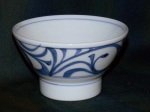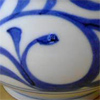Tobeyaki
 砥部焼き
砥部焼き
Background
- Blue and white coloured porcelain featuring simple patterns of arabesques and straight lines.
- Well known for hand painted wide, indigo coloured (藍色aiiro) lines on white porcelain (白磁 hakuji).
- Designs painted using indigo blue asbolite (呉須 gosu).
- Famous for being the first to make the popular kurawanka chawan (くらわんか茶碗) in the Edo period. Kurawanka chawan is a heavily built tea bowl with a high foot as shown below.
- Started as a pottery site in 1777 (mid-Edo period) after a porcelain firing process was completed under the guidance of Hizen potters.
- Low iron content porcelain stone and climibing kilns fired with pine improved the quality of the Tobe product
- Studio pottery processes were developed to enable mass production of ware that was exported through out South East Asian.
- Pottery production was disrupted by the global depression, Japanese military and imperial ambitions in Asian and by World War II.
- After the second world war, following visits from Yanagi Muneyoshi (柳宗悦) and Bernard Leach, and guidance and practical teaching from Hamada Shoji (濱田庄司), Tobeyaki potters returned to making high quality folk craft tableware. In doing so Tobeyaki became the biggest pottery site in Shikoku.
- There are now over 90 working kilns and 450 potters in Tobe.

Examples
Location
- Ehime prefecture
- 愛媛県/松山市、伊予郡松前町、砥部町
- 砥部焼伝統産業会館 TEL 0899-62-6600
- 砥部町陶芸創作館 TEL 0899-62-6145
Relevant posts and pages
External links
- The Tobe Pottery Traditional Industry Society 砥部焼伝統産業会館(Japanese 日本語)
- Tobe Pottery page on the Japanese Traditional Crafts website(Japanese 日本語)



















You must be logged in to post a comment.